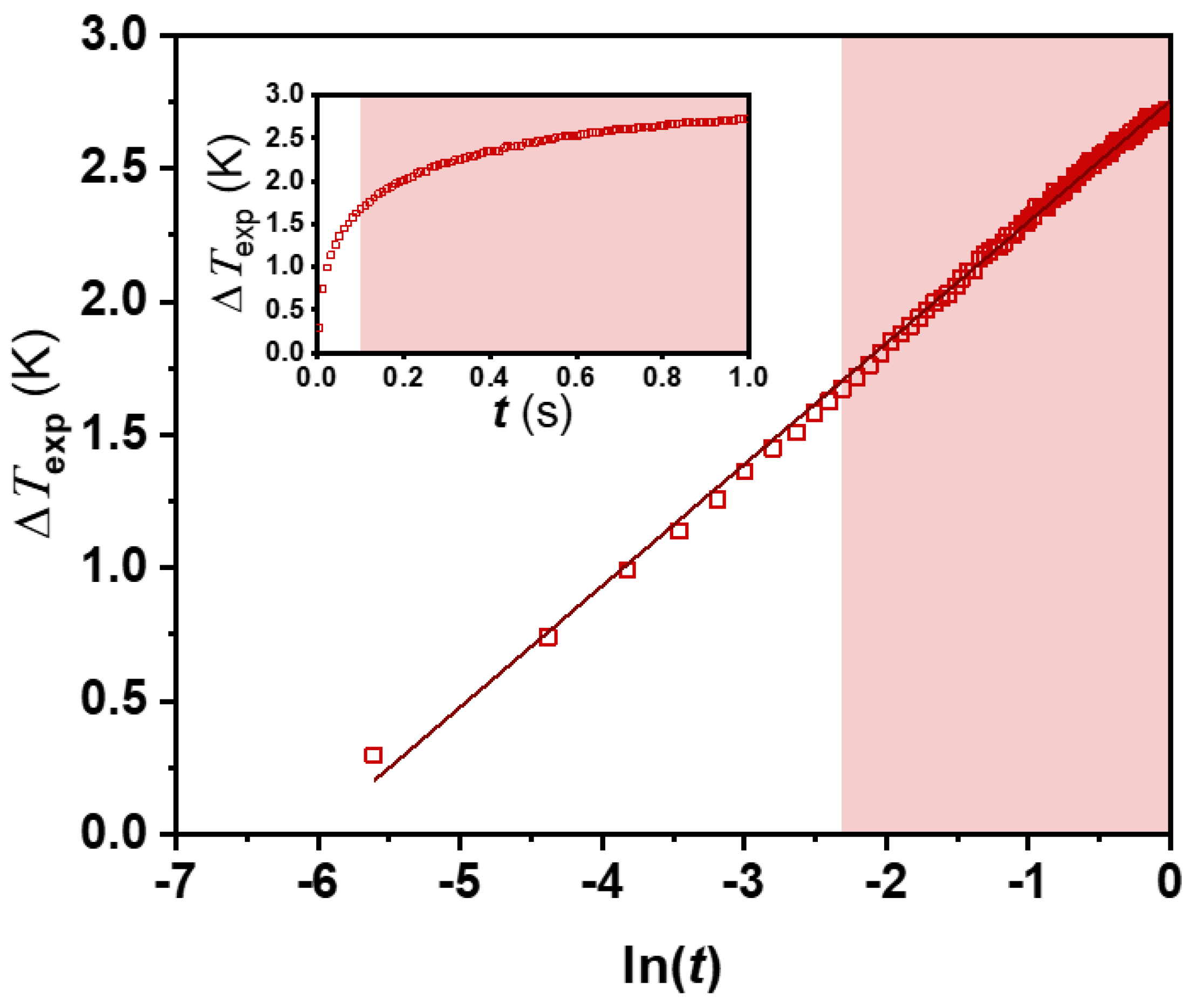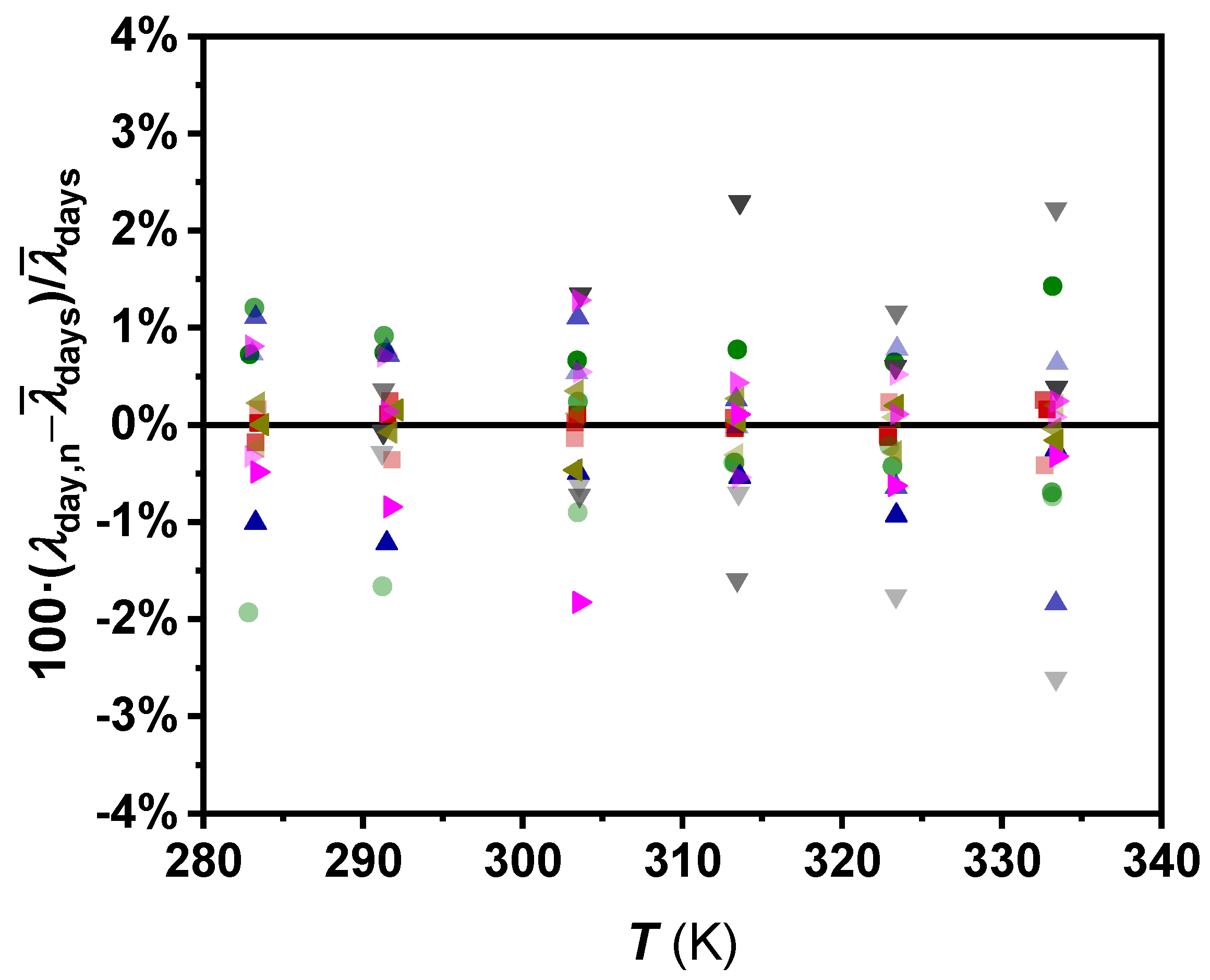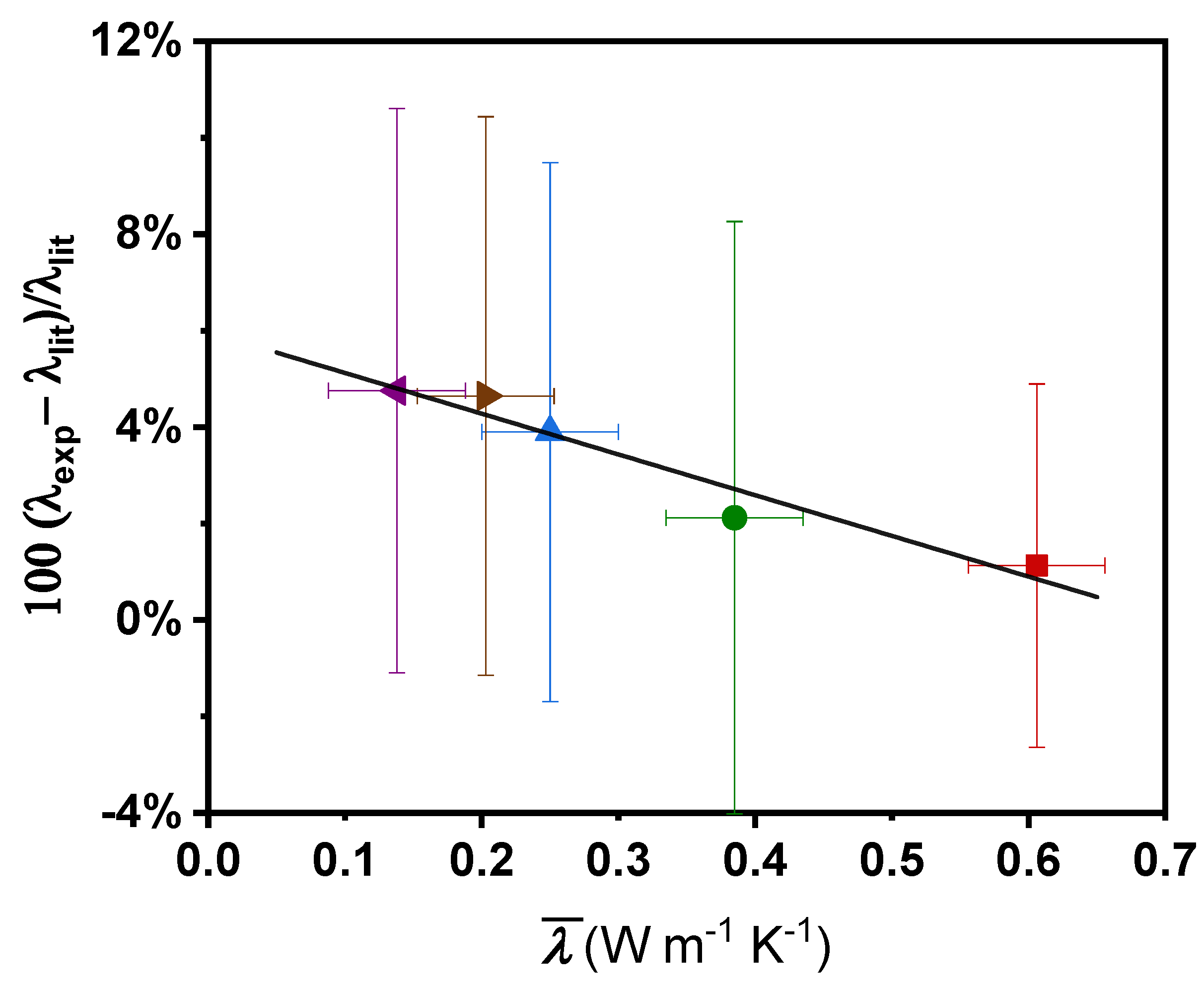Experimental Methodology to Determine Thermal Conductivity of Nanofluids by Using a Commercial Transient Hot-Wire Device †
Abstract
:1. Introduction
2. Thermal Conductivity Methods
2.1. General Statements
2.2. Transient Hot-Wire
3. Experimental Setup
3.1. Materials
3.2. Experimental Procedure
4. Results and Discussion
4.1. Validation of the Method
4.2. Repeatability and Comparison with Literature Data
4.3. Proposal of Correction Factor Δλ/λ
5. Conclusions
- The behavior of the device was checked by the ability to reproduce the theoretical THW curve and its linearization as ΔTexp-ln(t). Then, the deviation between the experimental data points and their linear fit emerging from the THW theory was found to be 1%. This departure of the experimental behavior from the THW model was discussed and analyzed to figure out which sources have some impact on it.
- Equivalently, from the thermal conductivity data of independent identical tests, the repeatability of the device was found to be 0.58%.
- Moreover, the experimental data here reported were compared to literature values, yielding the following mean deviations: 1.1% for W, 3.9% for EG, 4.6% for PG, 2.1% for EG:W 50:50, and 4.8% for n-C14.
- The obtained deviations show a systematic dependence on the thermal conductivity range of fluids, and an empirical correction factor has been proposed. This relationship is based on a linear regression of the deviation between experimental values and literature data, as a function of the mean thermal conductivity of the fluid.
- When all these considerations summarized above are taken into account and the recommendations stated in this paper are followed, an expanded (k = 2) uncertainty of 5% is estimated.
- Finally, two different fluids—n-C16 and MgO/n-C14 nanofluids at 1, 5, and 10 wt%—were also used to check the reliability of this proposal, and reductions in the thermal conductivity deviations from 7.5 to 2.3% for n-C16, and from 9.1 to 4.3% from 8.6 to 3.7% and from 9.3 to 4.4% for MgO/n-C14 at 1, 5, and 10 wt%, respectively, were obtained. Those new reported values are within the expanded uncertainty gathered in this work.
Author Contributions
Funding
Conflicts of Interest
References
- Nunes, V.M.B.; Lourenço, M.J.V.; Santos, F.J.V.; Lopes, M.L.S.M.; de Castro, C.A.N. Accurate Measurement of Physicochemical Properties on Ionic Liquids and Molten Salts. In Molten Salts and Ionic Liquids; Wiley: Hoboken, NJ, USA, 2010; pp. 229–263. [Google Scholar]
- Assael, M.J.; Antoniadis, K.D.; Wakeham, W.A. Historical Evolution of the Transient Hot-Wire Technique. Int. J. Thermophys. 2010, 31, 1051–1072. [Google Scholar] [CrossRef]
- Nieto de Castro, C.A.; Lourenço, M.J.V. Towards the Correct Measurement of Thermal Conductivity of Ionic Melts and Nanofluids. Energies 2020, 13, 99. [Google Scholar] [CrossRef] [Green Version]
- Palacios, A.; Cong, L.; Navarro, M.E.; Ding, Y.; Barreneche, C. Thermal conductivity measurement techniques for characterizing thermal energy storage materials—A review. Renew. Sustain. Energy Rev. 2019, 108, 32–52. [Google Scholar] [CrossRef]
- Paul, G.; Chopkar, M.; Manna, I.; Das, P.K. Techniques for measuring the thermal conductivity of nanofluids: A review. Renew. Sustain. Energy Rev. 2010, 14, 1913–1924. [Google Scholar] [CrossRef]
- Buongiorno, J.; Venerus, D.C.; Prabhat, N.; McKrell, T.; Townsend, J.; Christianson, R.; Tolmachev, Y.V.; Keblinski, P.; Hu, L.W.; Alvarado, J.L.; et al. A benchmark study on the thermal conductivity of nanofluids. J. Appl. Phys. 2009, 106, 094312. [Google Scholar] [CrossRef] [Green Version]
- Tertsinidou, G.; Assael, M.J.; Wakeham, W.A. The Apparent Thermal Conductivity of Liquids Containing Solid Particles of Nanometer Dimensions: A Critique. Int. J. Thermophys. 2015, 36, 2. [Google Scholar] [CrossRef]
- Berger Bioucas, F.E.; Rausch, M.H.; Schmidt, J.; Bück, A.; Koller, T.M.; Fröba, A.P. Effective Thermal Conductivity of Nanofluids: Measurement and Prediction. Int. J. Thermophys. 2020, 41, 55. [Google Scholar] [CrossRef] [Green Version]
- Murshed, S.M.S.; Nieto de Castro, C.A. Conduction and convection heat transfer characteristics of ethylene glycol based nanofluids—A review. Appl. Energy 2016, 184, 681–695. [Google Scholar] [CrossRef]
- Yüksel, N. The Review of Some Commonly Used Methods and Techniques to Measure the Thermal Conductivity of Insulation Materials. In Insulation Materials in Context of Sustainability; Almusaed, A., Almssad, A., Eds.; InTech: Rijeka, Croatia, 2016. [Google Scholar]
- Dubois, S.; Lebeau, F. Design, construction and validation of a guarded hot plate apparatus for thermal conductivity measurement of high thickness crop-based specimens. Mater. Struct. 2015, 48, 407–421. [Google Scholar] [CrossRef]
- Antoniadis, K.D.; Tertsinidou, G.J.; Assael, M.J.; Wakeham, W.A. Necessary Conditions for Accurate, Transient Hot-Wire Measurements of the Apparent Thermal Conductivity of Nanofluids are Seldom Satisfied. Int. J. Thermophys 2016, 37, 78. [Google Scholar] [CrossRef]
- Azarfar, S.; Movahedirad, S.; Sarbanha, A.A.; Norouzbeigi, R.; Beigzadeh, B. Low cost and new design of transient hot-wire technique for the thermal conductivity measurement of fluids. Appl. Therm. Eng. 2016, 105, 142–150. [Google Scholar] [CrossRef]
- Cabaleiro, D.; Nimo, J.; Pastoriza-Gallego, M.J.; Piñeiro, M.M.; Legido, J.L.; Lugo, L. Thermal conductivity of dry anatase and rutile nano-powders and ethylene and propylene glycol-based TiO2 nanofluids. J. Chem. Thermodyn. 2015, 83, 67–76. [Google Scholar] [CrossRef]
- Mirbagheri, M.H.; Akbari, M.; Mehmandoust, B. Proposing a new experimental correlation for thermal conductivity of nanofluids containing of functionalized multiwalled carbon nanotubes suspended in a binary base fluid. Int. Commun. Heat Mass Transf. 2018, 98, 216–222. [Google Scholar] [CrossRef]
- Liu, W.I.; Malekahmadi, O.; Bagherzadeh, S.A.; Ghashang, M.; Karimipour, A.; Hasani, S.; Tlili, I.; Goodarzi, M. A novel comprehensive experimental study concerned graphene oxide nanoparticles dispersed in water: Synthesise, characterisation, thermal conductivity measurement and present a new approach of RLSF neural network. Int. Commun. Heat Mass Transf. 2019, 109, 104333. [Google Scholar] [CrossRef]
- Bouchard, J.; Cayla, A.; Devaux, E.; Campagne, C. Electrical and thermal conductivities of multiwalled carbon nanotubes-reinforced high performance polymer nanocomposites. Compost. Sci. Technol. 2013, 86, 177–184. [Google Scholar] [CrossRef]
- Pátek, J.; Klomfar, J. Measurement of the thermal conductivity of argon and methane: A test of a transient hot-wire apparatus. Fluid Ph. Equilib. 2002, 198, 147–163. [Google Scholar] [CrossRef]
- Fujiura, K.; Nakamoto, Y.; Taguchi, Y.; Ohmura, R.; Nagasaka, Y. Thermal conductivity measurements of semiclathrate hydrates and aqueous solutions of tetrabutylammonium bromide (TBAB) and tetrabutylammonium chloride (TBAC) by the transient hot-wire using parylene-coated probe. Fluid Ph. Equilib. 2016, 413, 129–136. [Google Scholar] [CrossRef] [Green Version]
- De Groot, J.J.; Kestin, J.; Sookiazian, H. Instrument to measure the thermal conductivity of gases. Physica 1974, 75, 454–482. [Google Scholar] [CrossRef]
- Hammerschmidt, U.; Sabuga, W. Transient Hot Wire (THW) Method: Uncertainty Assessment. Int. J. Thermophys. 2000, 21, 1255–1278. [Google Scholar] [CrossRef]
- Carslaw, H.S.; Jaeger, J.C. Conduction of Heat in Solids, 2nd ed.; Oxford University Press: Oxford, UK, 1959. [Google Scholar]
- Abramowitz, H.; Stegun, I.A. Handbook of Mathematical Functions, 9th ed.; Dover Publications: New York, NY, USA, 1972. [Google Scholar]
- Healy, J.J.; de Groot, J.J.; Kestin, J. The theory of the transient hot-wire method for measuring thermal conductivity. Phys. B+C 1976, 82, 392–408. [Google Scholar] [CrossRef]
- Hong, S.W.; Kang, Y.-T.; Kleinstreuer, C.; Koo, J. Impact analysis of natural convection on thermal conductivity measurements of nanofluids using the transient hot-wire method. Int. J. Heat Mass Transf. 2011, 54, 3448–3456. [Google Scholar] [CrossRef]
- Shi, Y.; Sun, L.; Tian, F.; Venart, J.E.S.; Prasad, R.C. Fluid radiation effects in the transient hot-wire technique. J. Therm. Anal. Calorim. 2007, 90, 693–698. [Google Scholar] [CrossRef]
- Vatani, A.; Woodfield, P.L.; Dao, D.V. A miniaturized transient hot-wire device for measuring thermal conductivity of non-conductive fluids. Microsyst. Technol. 2016, 22, 2463–2466. [Google Scholar] [CrossRef]
- Mylona, S.K.; Yang, X.; Hughes, T.J.; White, A.C.; McElroy, L.; Kim, D.; Al Ghafri, S.; Stanwix, P.L.; Sohn, Y.H.; Seo, Y.; et al. High-Pressure Thermal Conductivity Measurements of a (Methane + Propane) Mixture with a Transient Hot-Wire Apparatus. J. Chem. Eng. Data 2020, 65, 906–915. [Google Scholar] [CrossRef]
- Vélez, C.; Reding, B.; Ortiz de Zárate, J.M.; Khayet, M. Thermal conductivity of water Ih-ice measured with transient hot-wires of different lengths. Appl. Therm. Eng. 2019, 149, 788–797. [Google Scholar] [CrossRef]
- Franco, A. An apparatus for the routine measurement of thermal conductivity of materials for building application based on a transient hot-wire method. Appl. Therm. Eng. 2007, 27, 2495–2504. [Google Scholar] [CrossRef]
- Castán-Fernández, C.; Marcos-Robredo, G.; Rey-Ronco, M.Á.; Alonso-Sánchez, T. Design, Construction and Commissioning of an Apparatus for Measuring the Thermal Conductivity of Geothermal Grouting Materials Based on the Transient Hot Wire Method. Proceedings 2018, 2, 1496. [Google Scholar] [CrossRef] [Green Version]
- Tian, F.; Sun, L.; Venart, J.E.S.; Prasad, R.C.; Mojumdar, S.C. Development of a thermal conductivity cell with nanolayer coating for thermal conductivity measurement of fluids. J. Therm. Anal. Calorim. 2008, 94, 37–43. [Google Scholar] [CrossRef]
- Tian, F.; Sun, L.; Mojumdar, S.C.; Venart, J.E.S.; Prasad, R.C. Absolute measurement of thermal conductivity of poly (acrylic acid) by transient hot wire technique. J. Therm. Anal. Calorim. 2011, 104, 823–829. [Google Scholar] [CrossRef]
- Prado, J.I.; Vallejo, J.P.; Lugo, L. A new relationship on transport properties of nanofluids. Evidence with novel magnesium oxide based n-tetradecane nanodispersions. Powder Technol. 2022; in press. [Google Scholar] [CrossRef]
- Prado, J.I.; Lugo, L. Enhancing the Thermal Performance of a Stearate Phase Change Material with Graphene Nanoplatelets and MgO Nanoparticles. ACS Appl. Mater. Interfaces 2020, 12, 39108–39117. [Google Scholar] [CrossRef] [PubMed]
- Beirão, S.G.S.; Ramires, M.L.V.; Dix, M.; de Castro, C.A.N. A New Instrument for the Measurement of the Thermal Conductivity of Fluids. Int. J. Thermophys. 2006, 27, 1018–1041. [Google Scholar] [CrossRef]
- Wagner, W.; Pruß, A. The IAPWS Formulation 1995 for the Thermodynamic Properties of Ordinary Water Substance for General and Scientific Use. J. Phys. Chem Ref. Data 2002, 31, 387–535. [Google Scholar] [CrossRef] [Green Version]
- Mariano, A.; Pastoriza-Gallego, M.J.; Lugo, L.; Mussari, L.; Piñeiro, M.M. Co3O4 ethylene glycol-based nanofluids: Thermal conductivity, viscosity and high pressure density. Int. J. Heat Mass Transf. 2015, 85, 54–60. [Google Scholar] [CrossRef]
- Peñas, J.R.V.; Ortiz de Zárate, J.M.; Khayet, M. Measurement of the thermal conductivity of nanofluids by the multicurrent hot-wire method. J. Appl. Phys. 2008, 104, 044314. [Google Scholar] [CrossRef] [Green Version]
- DiGuilio, R.; Teja, A. Thermal conductivity of poly (ethylene glycols) and their binary mixtures. J. Chem. Eng. Data 1990, 35, 117–121. [Google Scholar] [CrossRef]
- Assael, M.J.; Charitidou, E.; Avgoustiniatos, S.; Wakeham, W.A. Absolute measurements of the thermal conductivity of mixtures of alkene-glycols with water. Int. J. Thermophys. 1989, 10, 1127–1140. [Google Scholar] [CrossRef]
- Khayet, M.; Zárate, J.M.O.D. Application of the Multi-Current Transient Hot-Wire Technique for Absolute Measurements of the Thermal Conductivity of Glycols. Int. J. Thermophys. 2005, 26, 637–646. [Google Scholar] [CrossRef]
- Sun, T.; Teja, A.S. Density, Viscosity, and Thermal Conductivity of Aqueous Ethylene, Diethylene, and Triethylene Glycol Mixtures between 290 K and 450 K. J. Chem. Eng. Data 2003, 48, 198–202. [Google Scholar] [CrossRef]
- Said, Z.; Abdelkareem, M.A.; Rezk, H.; Nassef, A.M. Fuzzy modeling and optimization for experimental thermophysical properties of water and ethylene glycol mixture for Al2O3 and TiO2 based nanofluids. Powder Technol. 2019, 353, 345–358. [Google Scholar] [CrossRef]
- Suseel Jai Krishnan, S.; Nagarajan, P.K. Experimental study on thermal conductivity of solution combustion synthesized MgO nanoparticles dispersed in water and ethylene glycol (50:50) binary mixture. AIP Conf. Proc. 2017, 1832, 050074. [Google Scholar]
- Melinder, Å. Thermophysical Properties of Aqueous Solutions Used as Secondary Working Fluids. Ph.D. Thesis, KTH Royal Institute of Technology, Stockholm, Sweden, 2007. [Google Scholar]
- Jiang, H.; Xu, Q.; Huang, C.; Shi, L. Effect of temperature on the effective thermal conductivity of n-tetradecane-based nanofluids containing copper nanoparticles. Particuology 2015, 22, 95–99. [Google Scholar] [CrossRef]
- Kenisarin, M.M. Thermophysical properties of some organic phase change materials for latent heat storage. A review. Sol. Energy 2014, 107, 553–575. [Google Scholar] [CrossRef]
- Kian, K.; Scurto, A.M. Heat Transport Properties of CO2-Expanded Liquids: N-Hexane, n-Decane, and n-Tetradecane. Ind. Eng. Chem. Res. 2017, 56, 12822–12832. [Google Scholar] [CrossRef]
- McLaughlin, E.; Pittman, J.F.T. Determination of the Thermal Conductivity of Toluene-A Proposed Data Standard-from 180 to 400k under Saturation Pressure by the Transient Hot-Wire Method I. The Theory of the Technique. Philos. Trans. Royal Soc. A 1971, 270, 557–578. [Google Scholar]
- Vélez, C.; Khayet, M.; Ortiz de Zárate, J.M. Temperature-dependent thermal properties of solid/liquid phase change even-numbered n-alkanes: N-Hexadecane, n-octadecane and n-eicosane. Appl. Energy 2015, 143, 383–394. [Google Scholar] [CrossRef]
- Mustafaev, R.A. Thermal conductivity of higher saturated n-hydrocarbons over wide ranges of temperature and pressure. J. Eng. Phys. 1973, 24, 465–469. [Google Scholar] [CrossRef]
- Monogenidou, S.A.; Assael, M.J.; Huber, M.L. Reference Correlation for the Thermal Conductivity of n-Hexadecane from the Triple Point to 700 K and up to 50 MPa. J. Phys. Chem. Ref. Data 2018, 47, 013103. [Google Scholar] [CrossRef] [PubMed]
- Wada, Y.; Nagasaka, Y.; Nagashima, A. Measurements and correlation of the thermal conductivity of liquid n-paraffin hydrocarbons and their binary and ternary mixtures. Int. J. Thermophys. 1985, 6, 251–265. [Google Scholar] [CrossRef]






| Method | Temperature Range (K) | Thermal Conductivity Range (W m−1 K−1) | Measure Time (s) | Advantages | Disadvantages |
|---|---|---|---|---|---|
| STEADY-STATE METHODS | |||||
| Guarded hot plate b | 113–973 | 0.01–6 | From hours to weeks | High accuracy, adjustable to the sample thickness | Time -consuming, large specimen, not suitable for film-like samples |
| Heat flow Meter b | 173–473 | <0.3 | Shorter than guarded hot plate | Simple construction and operation | Measurement uncertainty, non-absolute method |
| TRANSIENT METHODS | |||||
| Transient plane source c | 238–1273 | 0.001–1800 | Few seconds | Rapid and precise, wide temperature and thermal conductivity range | Require entirely planar side of sample, not suitable for powders or granules |
| Laser flash c | 153–3073 | 0.1–1000 | 1–2 | Wide temperature range, small sample, fast, accuracy at high temperature | More expensive, not suitable for insulation materials |
| Modulated DSC c | 190–670 | 0.1–1 | 10–100 | Sensitive and accurate | Expensive than conventional DSC |
| 3ω method c | 308–773 | 0.2–20 | Few seconds | Wide temperature range, acceptable accuracy, and insensitive to black-body radiation | Not suitable for electrically conductive samples |
| Transient hot-wire a | 123–473 | 0.005–500 | 10−3–1 (fluid) 10 (solid) | Fast, accurate | Limited to materials with low electrical conductivity (bare wire), delicate thin wire |
| Corrections | |δTi| (K) | |δTi|/ΔTexp (%) |
|---|---|---|
| δT1 | 2.5 × 10−4 | 1 × 10−2 |
| δT2 | 1.2 × 10−4 | 4 × 10−3 |
| δT4 | 2.5 × 10−13 | 1 × 10−11 |
| δT5 | 1.7 × 10−9 | 7 × 10−8 |
| δT7 | 2.4 × 10−12 | 1 × 10−10 |
| δT9 | 2.2 × 10−10 | 1 × 10−8 |
Publisher’s Note: MDPI stays neutral with regard to jurisdictional claims in published maps and institutional affiliations. |
© 2021 by the authors. Licensee MDPI, Basel, Switzerland. This article is an open access article distributed under the terms and conditions of the Creative Commons Attribution (CC BY) license (https://creativecommons.org/licenses/by/4.0/).
Share and Cite
Prado, J.I.; Calviño, U.; Lugo, L. Experimental Methodology to Determine Thermal Conductivity of Nanofluids by Using a Commercial Transient Hot-Wire Device. Appl. Sci. 2022, 12, 329. https://doi.org/10.3390/app12010329
Prado JI, Calviño U, Lugo L. Experimental Methodology to Determine Thermal Conductivity of Nanofluids by Using a Commercial Transient Hot-Wire Device. Applied Sciences. 2022; 12(1):329. https://doi.org/10.3390/app12010329
Chicago/Turabian StylePrado, Jose I., Uxía Calviño, and Luis Lugo. 2022. "Experimental Methodology to Determine Thermal Conductivity of Nanofluids by Using a Commercial Transient Hot-Wire Device" Applied Sciences 12, no. 1: 329. https://doi.org/10.3390/app12010329
APA StylePrado, J. I., Calviño, U., & Lugo, L. (2022). Experimental Methodology to Determine Thermal Conductivity of Nanofluids by Using a Commercial Transient Hot-Wire Device. Applied Sciences, 12(1), 329. https://doi.org/10.3390/app12010329








